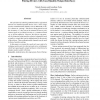Free Online Productivity Tools
i2Speak
i2Symbol
i2OCR
iTex2Img
iWeb2Print
iWeb2Shot
i2Type
iPdf2Split
iPdf2Merge
i2Bopomofo
i2Arabic
i2Style
i2Image
i2PDF
iLatex2Rtf
Sci2ools
ICDCSW
2008
IEEE
2008
IEEE
Pairing Devices with Good Quality Output Interfaces
The operation of achieving authenticated key agreement between two human-operated devices over a short range wireless communication channel, such as Bluetooth or WiFi, is known as “pairing.” The devices being paired are ad hoc in nature, i.e., they can not be assumed to have a prior context (such as pre-shared secrets) or a common trusted on- or off-line authority. However, the devices can generally be connected using auxiliary physical channel(s) (such as audio or visual) that can be authenticated by the user(s) of the devices. These authenticatable channels can be used to form a basis for pairing. In this paper, we present the results of a user study of a technique used to pair two devices (such as two cell phones) which have good quality output interfaces in the form of a display, speaker, and/or vibration.
Authenticated Key Agreement | Distributed And Parallel Computing | Human-operated Devices | ICDCSW 2008 | Range Wireless Communication |
| Added | 30 May 2010 |
| Updated | 30 May 2010 |
| Type | Conference |
| Year | 2008 |
| Where | ICDCSW |
| Authors | Nitesh Saxena, Jonathan Voris |
Comments (0)

